Jiahao Zheng
QuantBench: Benchmarking AI Methods for Quantitative Investment
Apr 24, 2025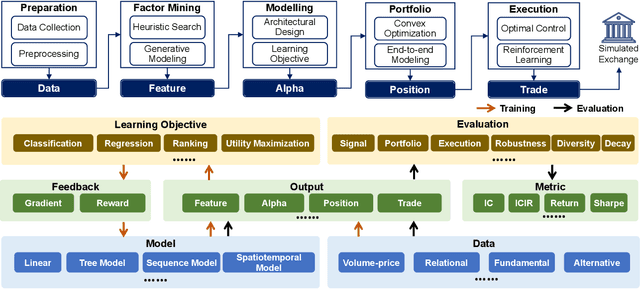



Abstract:The field of artificial intelligence (AI) in quantitative investment has seen significant advancements, yet it lacks a standardized benchmark aligned with industry practices. This gap hinders research progress and limits the practical application of academic innovations. We present QuantBench, an industrial-grade benchmark platform designed to address this critical need. QuantBench offers three key strengths: (1) standardization that aligns with quantitative investment industry practices, (2) flexibility to integrate various AI algorithms, and (3) full-pipeline coverage of the entire quantitative investment process. Our empirical studies using QuantBench reveal some critical research directions, including the need for continual learning to address distribution shifts, improved methods for modeling relational financial data, and more robust approaches to mitigate overfitting in low signal-to-noise environments. By providing a common ground for evaluation and fostering collaboration between researchers and practitioners, QuantBench aims to accelerate progress in AI for quantitative investment, similar to the impact of benchmark platforms in computer vision and natural language processing.
Generative Semantic Communication for Text-to-Speech Synthesis
Oct 04, 2024Abstract:Semantic communication is a promising technology to improve communication efficiency by transmitting only the semantic information of the source data. However, traditional semantic communication methods primarily focus on data reconstruction tasks, which may not be efficient for emerging generative tasks such as text-to-speech (TTS) synthesis. To address this limitation, this paper develops a novel generative semantic communication framework for TTS synthesis, leveraging generative artificial intelligence technologies. Firstly, we utilize a pre-trained large speech model called WavLM and the residual vector quantization method to construct two semantic knowledge bases (KBs) at the transmitter and receiver, respectively. The KB at the transmitter enables effective semantic extraction, while the KB at the receiver facilitates lifelike speech synthesis. Then, we employ a transformer encoder and a diffusion model to achieve efficient semantic coding without introducing significant communication overhead. Finally, numerical results demonstrate that our framework achieves much higher fidelity for the generated speech than four baselines, in both cases with additive white Gaussian noise channel and Rayleigh fading channel.
AdvSV: An Over-the-Air Adversarial Attack Dataset for Speaker Verification
Oct 09, 2023Abstract:It is known that deep neural networks are vulnerable to adversarial attacks. Although Automatic Speaker Verification (ASV) built on top of deep neural networks exhibits robust performance in controlled scenarios, many studies confirm that ASV is vulnerable to adversarial attacks. The lack of a standard dataset is a bottleneck for further research, especially reproducible research. In this study, we developed an open-source adversarial attack dataset for speaker verification research. As an initial step, we focused on the over-the-air attack. An over-the-air adversarial attack involves a perturbation generation algorithm, a loudspeaker, a microphone, and an acoustic environment. The variations in the recording configurations make it very challenging to reproduce previous research. The AdvSV dataset is constructed using the Voxceleb1 Verification test set as its foundation. This dataset employs representative ASV models subjected to adversarial attacks and records adversarial samples to simulate over-the-air attack settings. The scope of the dataset can be easily extended to include more types of adversarial attacks. The dataset will be released to the public under the CC-BY license. In addition, we also provide a detection baseline for reproducible research.
IMM: An Imitative Reinforcement Learning Approach with Predictive Representation Learning for Automatic Market Making
Aug 17, 2023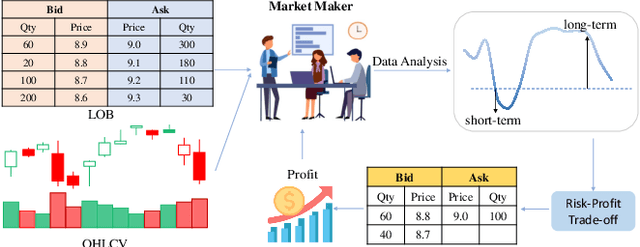

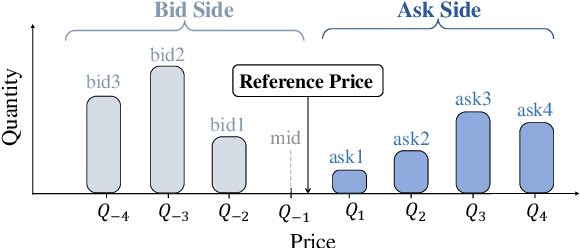

Abstract:Market making (MM) has attracted significant attention in financial trading owing to its essential function in ensuring market liquidity. With strong capabilities in sequential decision-making, Reinforcement Learning (RL) technology has achieved remarkable success in quantitative trading. Nonetheless, most existing RL-based MM methods focus on optimizing single-price level strategies which fail at frequent order cancellations and loss of queue priority. Strategies involving multiple price levels align better with actual trading scenarios. However, given the complexity that multi-price level strategies involves a comprehensive trading action space, the challenge of effectively training profitable RL agents for MM persists. Inspired by the efficient workflow of professional human market makers, we propose Imitative Market Maker (IMM), a novel RL framework leveraging both knowledge from suboptimal signal-based experts and direct policy interactions to develop multi-price level MM strategies efficiently. The framework start with introducing effective state and action representations adept at encoding information about multi-price level orders. Furthermore, IMM integrates a representation learning unit capable of capturing both short- and long-term market trends to mitigate adverse selection risk. Subsequently, IMM formulates an expert strategy based on signals and trains the agent through the integration of RL and imitation learning techniques, leading to efficient learning. Extensive experimental results on four real-world market datasets demonstrate that IMM outperforms current RL-based market making strategies in terms of several financial criteria. The findings of the ablation study substantiate the effectiveness of the model components.
Multimodal Representations Learning Based on Mutual Information Maximization and Minimization and Identity Embedding for Multimodal Sentiment Analysis
Jan 10, 2022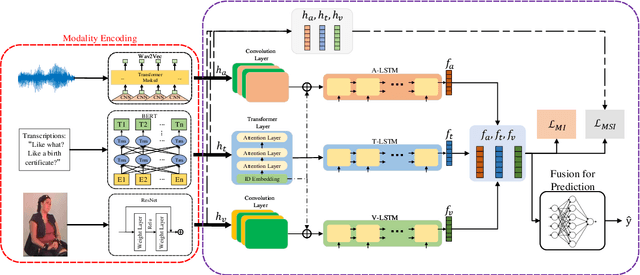
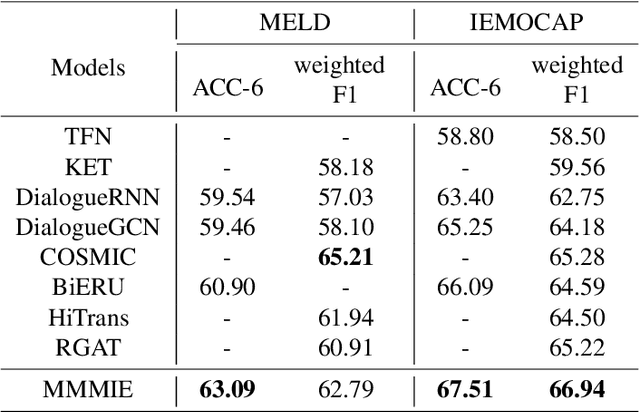

Abstract:Multimodal sentiment analysis (MSA) is a fundamental complex research problem due to the heterogeneity gap between different modalities and the ambiguity of human emotional expression. Although there have been many successful attempts to construct multimodal representations for MSA, there are still two challenges to be addressed: 1) A more robust multimodal representation needs to be constructed to bridge the heterogeneity gap and cope with the complex multimodal interactions, and 2) the contextual dynamics must be modeled effectively throughout the information flow. In this work, we propose a multimodal representation model based on Mutual information Maximization and Minimization and Identity Embedding (MMMIE). We combine mutual information maximization between modal pairs, and mutual information minimization between input data and corresponding features to mine the modal-invariant and task-related information. Furthermore, Identity Embedding is proposed to prompt the downstream network to perceive the contextual information. Experimental results on two public datasets demonstrate the effectiveness of the proposed model.
ElegantRL-Podracer: Scalable and Elastic Library for Cloud-Native Deep Reinforcement Learning
Dec 11, 2021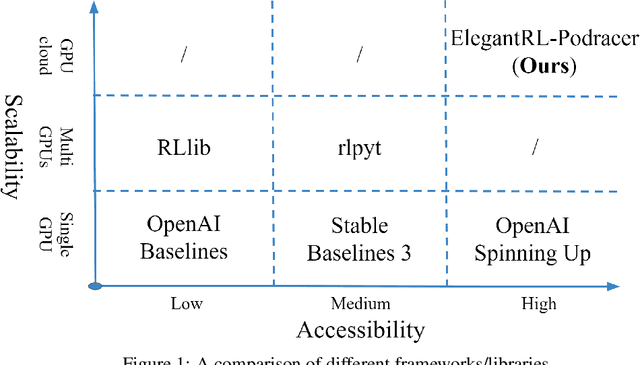
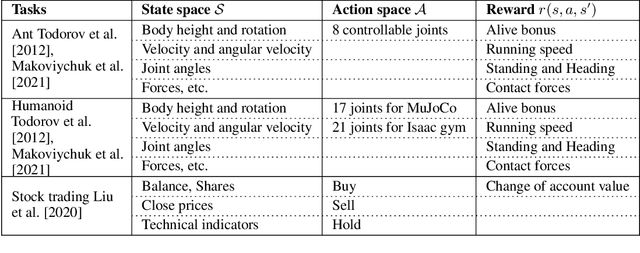
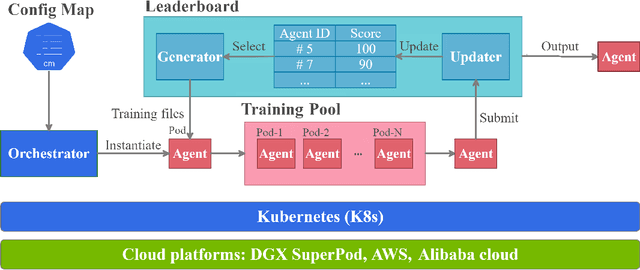

Abstract:Deep reinforcement learning (DRL) has revolutionized learning and actuation in applications such as game playing and robotic control. The cost of data collection, i.e., generating transitions from agent-environment interactions, remains a major challenge for wider DRL adoption in complex real-world problems. Following a cloud-native paradigm to train DRL agents on a GPU cloud platform is a promising solution. In this paper, we present a scalable and elastic library ElegantRL-podracer for cloud-native deep reinforcement learning, which efficiently supports millions of GPU cores to carry out massively parallel training at multiple levels. At a high-level, ElegantRL-podracer employs a tournament-based ensemble scheme to orchestrate the training process on hundreds or even thousands of GPUs, scheduling the interactions between a leaderboard and a training pool with hundreds of pods. At a low-level, each pod simulates agent-environment interactions in parallel by fully utilizing nearly 7,000 GPU CUDA cores in a single GPU. Our ElegantRL-podracer library features high scalability, elasticity and accessibility by following the development principles of containerization, microservices and MLOps. Using an NVIDIA DGX SuperPOD cloud, we conduct extensive experiments on various tasks in locomotion and stock trading and show that ElegantRL-podracer substantially outperforms RLlib. Our codes are available on GitHub.
* 9 pages, 7 figures
 Add to Chrome
Add to Chrome Add to Firefox
Add to Firefox Add to Edge
Add to Edge